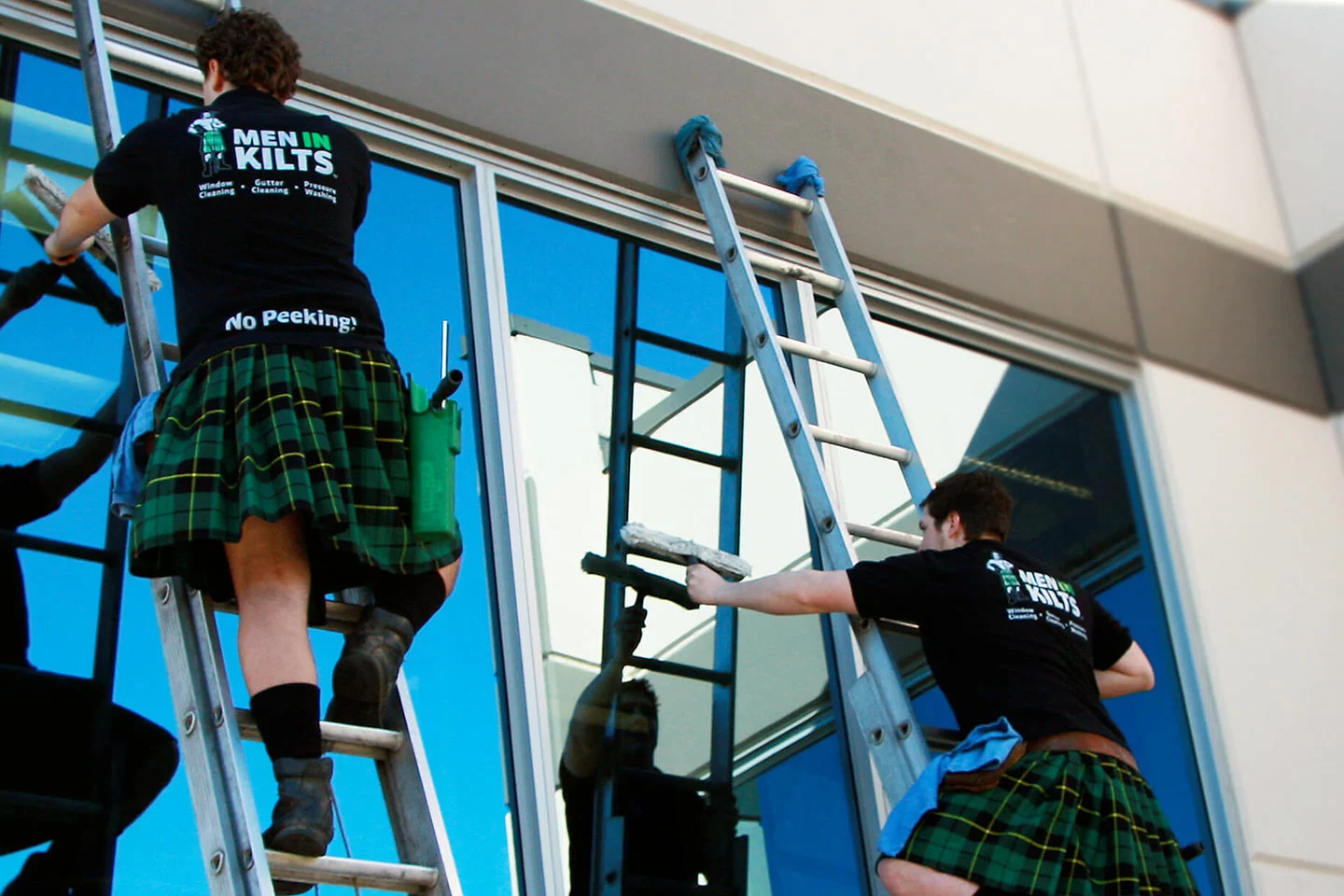Now, more than ever, it’s critical that businesses move beyond “silver bullet” marketing – only employing a single marketing tactic and assuming your business will soar. Effective marketing demands multiple touch points to convert a stranger into a buyer, and your strategy needs to reflect this.
In order to beat out competitors and rise to the top of your market you need to tie together your outbound marketing, inbound marketing and customer experience into a cohesive customer journey that guides users through each stage of your funnel. This is where industry-leading results are found.
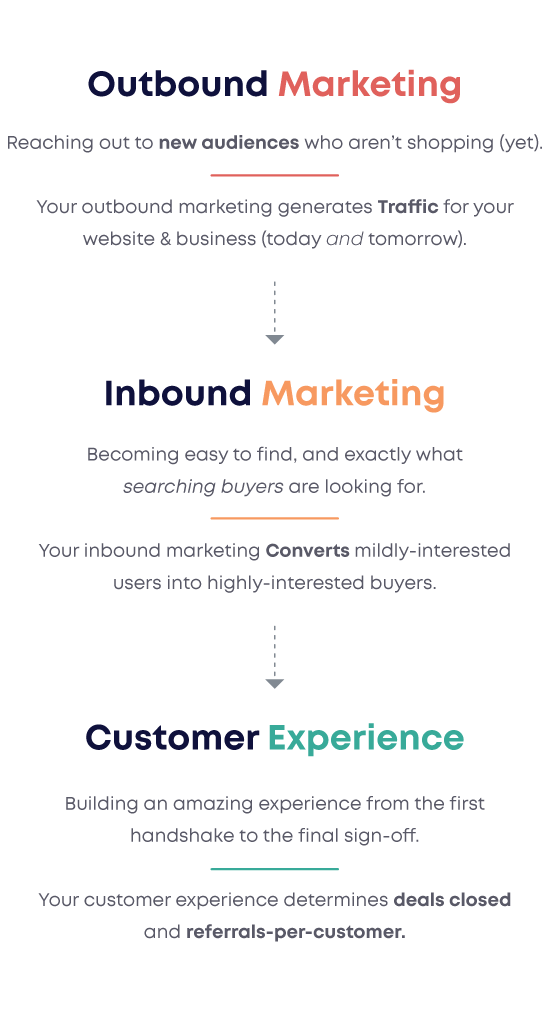
1. Outbound Marketing –
Building Interest & Awareness
Definition: All of the actions your business takes in order to reach out to new audiences who haven’t heard of you (yet).
Why is Outbound Marketing Important?
Outbound marketing is designed to generate interest & awareness for your website and business both today and tomorrow. We see examples of this every day from consumer brands – TV commercials, Facebook ads, magazines, bus benches, billboards, mail outs, etc.
Every one of these tactics aim at the same goals:
- To increase awareness and familiarity with your brand (building trust)
- To generate interest – people browsing your social media, website, and storefront
- To keep you “top of mind” when the prospect enters a potential buying window
And alongside B2C tactics, we see the same goals served within B2B Outbound Marketing – trade shows, networking, sponsored events, prospecting and account-based marketing. Every business should be engaged in reaching new audiences outside of their existing circles, and Outbound Marketing is the key to this.
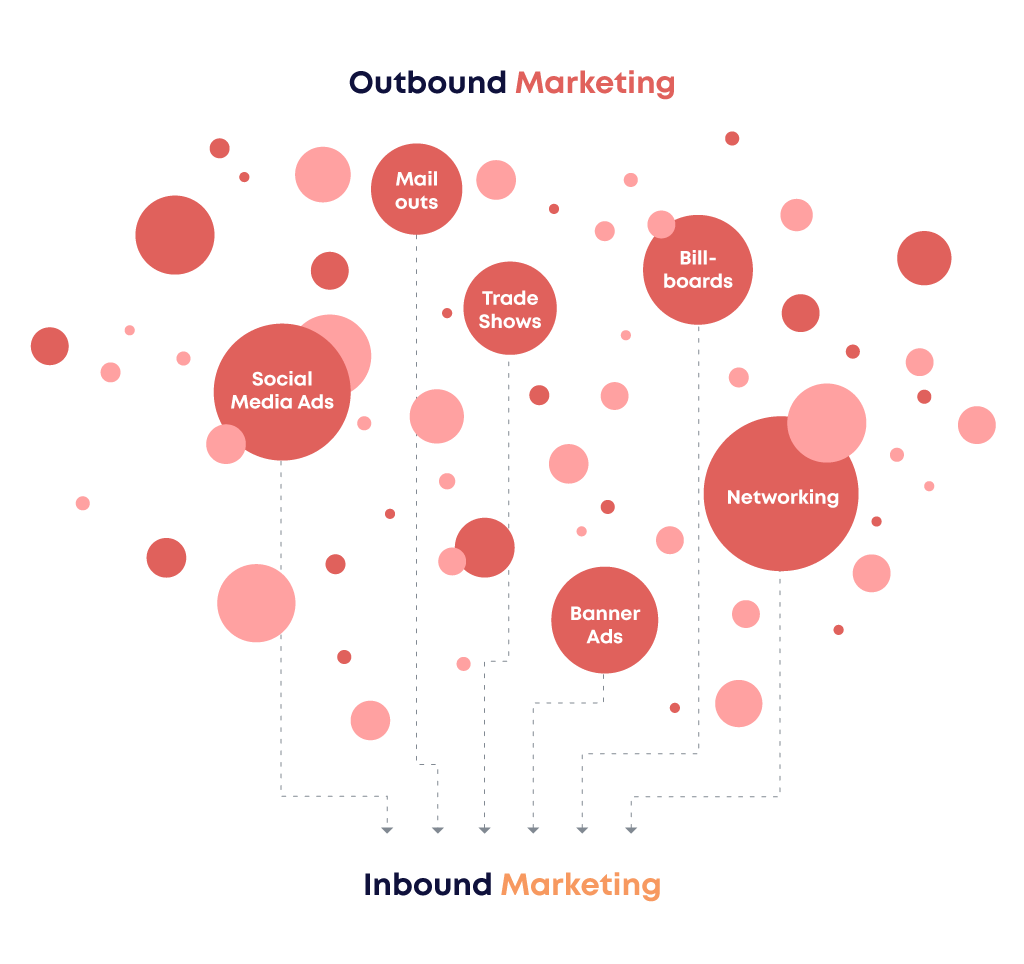
Tailored to Market
Depending on if you’re a B2B (Business selling to Business) or B2C (Business selling to Consumer) company, your tactics will vary quite a bit. Much of this is due to the logistics of the audience size and purchase size. Small audiences and large purchases (like a fleet of trucks) will mean you can spend a lot on winning over a select number of people, whereas large audiences with small purchases (like chewing gum) mean you can target large volumes, but the cost-per-impression has to be pennies. Depending on your product and target market, this will give you a strong indication of where you can develop new Outbound Marketing tactics.
- B2C (or large-audience + small-purchase) would typically tap into:
- Online display ads
- TV & radio
- Mass mail outs
- Public Relations (PR) campaigns
- Signage & billboards
- B2B (or small-audience + large-purchase) would typically tap into:
- Networking & events
- Direct mail campaigns (to targeted people)
- Trade shows
- Industry magazines & news sources
- Prospecting and Account-Based Marketing
Regardless of which avenues you pursue, make sure your tactics have been planned around your product, and that it’s tailored to your audience.
How Do You Measure Success?
The most contentious discussion with outbound marketing is how you’re measuring its success. While businesses yearn to measure this through sales and leads, this approach fails to factor in the place of Outbound Marketing within the customer journey. Outbound campaigns are designed to reach those in your target market who have never heard of you, may not be shopping right now, but are still worth an introduction to your brand. So what do you measure?
Interest & Awareness
The most effective way to measure the success of your outbound marketing is by counting how many viewers (who match your target market) see your brand and simply take the next step. For online ads this means measuring impressions and clicks per dollar spent, as well as click-through-rate (CTR). Impressions and clicks per dollar spent will be a great comparison of the ROI of the avenue you’ve chosen; CTR will be a great measure of the quality of the ad and the targeting (higher CTR is usually an indication of a great ad and great targeting). Offline you can still approximate the number of impressions/views, but you’ll want to spend time considering how to measure “taking the next step”. QR codes, custom campaign URLs, and custom phone numbers (not your normal phone line) are common ways to give viewers a measurable next step.
This is why outbound measurements are contentious – no matter how much your boss wants to measure Outbound via customers and leads, this is not the purpose (or the place) to push for this metric. If you try and squeeze sales out of your “first impression” marketing, you’ll break trust, annoy your market, and the stats will reflect this. But if you can convince your team to plant seeds instead of digging for food, your long game will reap a rich harvest, and your Outbound Marketing will boost the ROI of your Inbound and Customer Experience efforts.
2. Inbound Marketing –
Be Findable & Convert Browsing into Buying
Definition: When prospective customers are already inbound toward a solution, these are the tactics to make your business easier to find, and convert these shoppers into leads.
Why is Your Inbound Marketing Important?
For most businesses this is where marketing gets really exciting. It’s practical, measurable, and everyone agrees it’s effective. And therein lies the problem – everyone else is doing it too. If your businesses is looking for a competitive edge, the bar is high, and your customer’s discernment even higher.
Ideally, Inbound Marketing should act as a funnel, drawing interested individuals into your sales cycle. Just as all roads lead to Rome, all inbound tactics should lead to your sales team (or shopping cart). Your two objectives in Inbound Marketing are to:
- Be as findable as possible whether someone searches for your name, your services, or the problems you solve
- Once they find you, curate a journey that leads them straight to your door (online or in the flesh)
Your Inbound Marketing will also recapture many of your Outbound acquaintances. Think of it this way, whether you ran ads online, sent a piece of mail, or handed over a business card, where would the potential buyer go next? They’d look you up online. Whether they’re searching out where your shop is, or digging through your website, MOST of your Outbound Marketing will find it’s way into your Inbound market. Then it’s time to convert them into a lead…
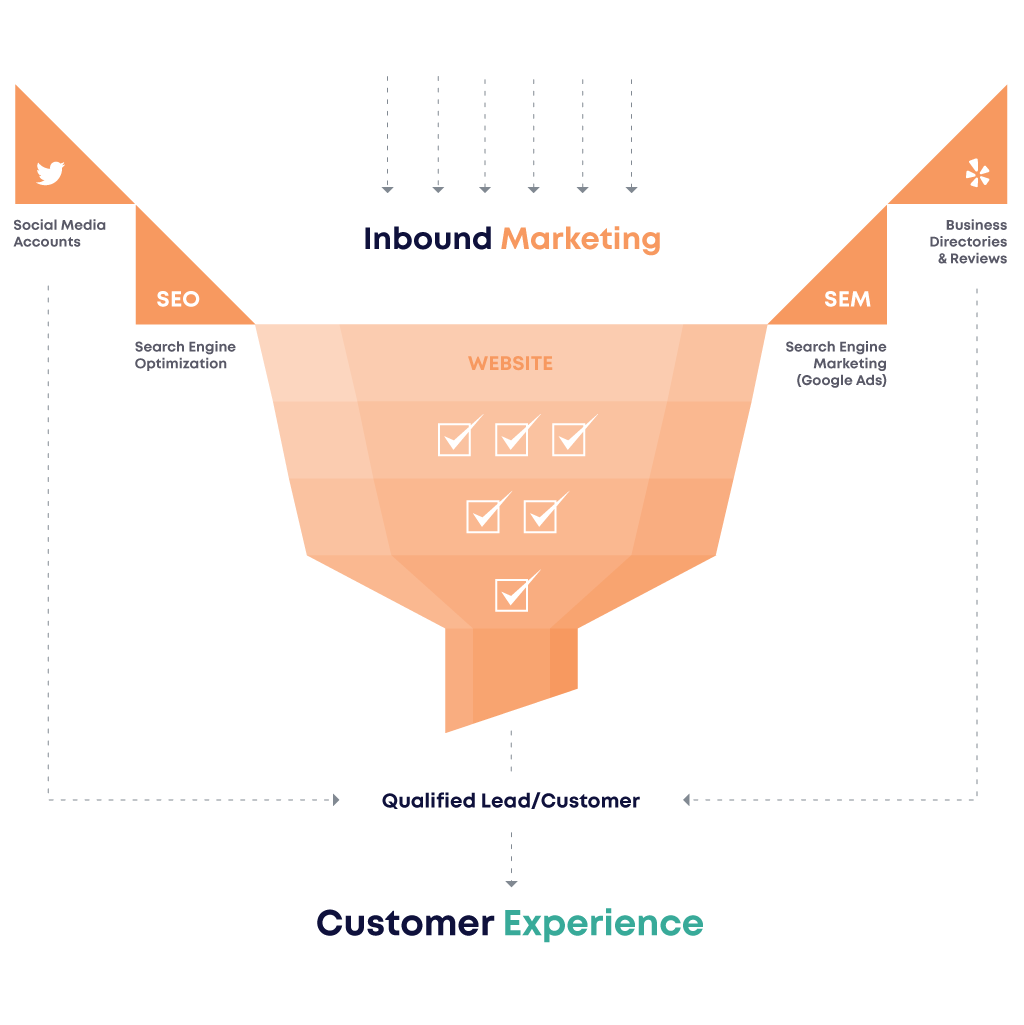
Improving Conversion
Before we talk about making yourself more findable, let’s talk about your website. While some small businesses sell products right within their social media, and some searchers may call the number on your Google Business profile, the vast majority of your prospective clients will need to either visit your store or browse your website. We’ll talk more about store visits as part of the Customer Experience Marketing, which means unless your prospects walk straight to your door, your website better be very good…
The Website
When it comes to inbound marketing, your website is your biggest asset. If you want your website to improve your conversion rate, you’ll need to assess three key areas: your message, your design and the website structure.
- The Message: We lean on two areas content creation. The first is your brand message – setting the customer as the hero in your story and building emotional attachment to the outcomes you offer. The second is building your website content around the critical questions a prospective buyer needs to answer before they’d be willing to take action. Both of these are extremely customer-centric, and as such, have a profound effect on customer behaviour.
- The Design: Similar to the message, this is a communication strategy. The design must connect your brand to how the customer thinks of themself – “people like me buy from companies like this”. The second role of the design is to build a seamless experience for the user – de-cluttering the journey, immediately seeing where to click, and seamlessly flowing from step to step.
- Website Structure: Lastly, a lot of thought needs to be put into website structure. Design and message can’t overcome a labyrinth of pages and options.
- Make it easy for users to say “yes, that’s me” and design your navigation around your customer
- Reduce the options to only what the user needs in that moment (then open more options as they dive deeper)
- Use Calls to Action (CTAs) to continually draw the user closer to your goal
- Design your website as a funnel – no matter which path they take, it eventually leads to contacting you
Widening The Funnel
Not everyone will be able to find you. Whether they Googled your services, searched the problem their facing, or couldn’t quire remember your name, sometimes you need to cast a wider net in order to capture the clients who are searching. For those who don’t immediately find your website, businesses have a number of options to widen the funnel and increase their online presence:
- Business Listings – Google, Bing, Apple Maps, etc. — all of these help people find you more easily and are the first touch point in building trust (those star ratings really do make a difference!)
- Search Engine Optimization (SEO) – Think of this as all activities you do so that search engines can see what you offer, evaluate if people need it, and connect it with relevant searches. It doesn’t reach people who didn’t search, but it does capture the ones who do.
- Search Engine Marketing (SEM) – Also known as search ads, for all those search terms that you don’t automatically rank on page 1, Google is more than happy to take a little money and place you there. It’s not nearly as good as being #1, but it’s the next best thing.
- Social Media Presence – Keep in mind that this is not the same as social media ads (which reach new audiences) – your social media accounts are simply to connect with those who look for you and can help you connect with your audience in consistent, meaningful ways.
All of the above are part of your inbound marketing strategy – ensuring those who are inbound toward a solution will find you. It’s also important to note that each have elements of “conversion” as well – increasing the likelihood of converting a mildly interested visitor into a highly engaged lead. Improving your number of 5-star reviews, or your social media presence are valuable trust-builders, and a high rank on Google can also increase trust, and better ad text as well.
How Do You Measure the Success of Your Inbound Marketing?
In tackling this question we would typically divide up the efforts focused on generating traffic (ie. more people visiting) from those focused on increasing conversion (ie. more people contacting you). Each have their place in your strategy, and each have their own success metrics.
- Increasing Traffic – For tactics like SEO, SEM, and Business Listings, your Key Performance Indicator (KPI) is going to hinge on how many qualified visitors come to your site/store for every dollar you spend. IE. Company A spent $200 and got 70 clicks to their website, so the cost per click is $2.86; whereas they spent $2000 on SEO and in the year following increase organic traffic by 3000 people, so this (likely) gave them a cost per click of $1.50. Comparatively the SEO was better, but if both methods are bringing in customers at a reasonable ROI, they’d likely continue running both.
- Increasing Conversion – For 80% of businesses your website will stand at the center of your funnel, and the focus here is on conversion. It is not your website’s job to attract visitors; it’s your website’s job to turn them into leads and sales. We would measure this as a percentage. IE. 10,000 visitors (who match our target market) came in; 5% contacted us. After our $25,000 website redesign, we now have 10% converting, which means the ROI of our $2000/mo ad spend just doubled.
Without traffic, your website can’t build your revenue, and without a high-conversion website, your advertising and online presence can’t build revenue. And again, a sales team without leads will fail, and leads sent to a poorly equipped sales team will fail. This is exactly why silver bullet marketing is ineffective – you’re building a system which relies on every other part of the system working.
Which brings us to the Customer Experience…
Customer Experience –
Sales Enablement, Reviews & Referrals
Definition: The tactical changes you make to increase the revenue gained from the relationships you already have.
Why is Customer Experience Part of Marketing?
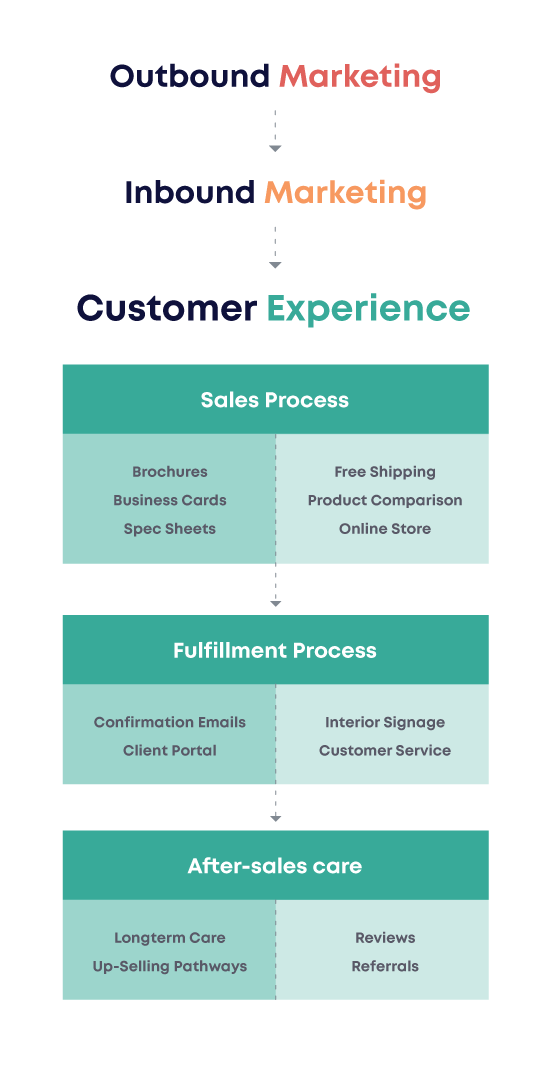
How Do You Increase Referrals & Reviews Through Customer Experience?
We’ll be honest – there are endless ways to build a better experience, all of which will increase reviews, referrals and repeat buyers. BUT there is one area that most businesses are missing — the after-sale experience. While many businesses are eager to grab the cheque, shake hands and move on, there’s far higher ROI in sticking around.
Within your business, ask these key questions:
- How/when are we asking for reviews?
- How/when are we asking for referrals?
- What/when are our upselling opportunities before or after project completion?
- How do we guarantee the customer is smiling when they pay the final bill?
- 2, 4, and 8 months after, how do we show the customer we care about them?
After you’ve improved your “end of journey,” take a second look at your sales process. This is a matter of asking your sales team if there are any tools or assets which could make their job a little easier. What would help them “wow” every prospect they meet?
- A stunning service document or “take-away” item
- Powerful digital assets on the website or in an easy-to-email format
- A proper Customer Relationship Manager (CRM) to track interactions
- Onboarding materials which smooth the hand-off to the operations team
- Or sometimes, just a really nice business card…
How Do You Measure the Success of Your Customer Experience?
Most businesses would say that by fulfilling everything they promised they have delivered a great experience. That’s not success – that just means you’re not in breach of contract (so please don’t applaud). A successful customer experience is measured through the percentage of deals you close, the ratio of positive reviews compared to customers and the ratio of referrals compared to customers. When you take the time to improve your CXM, you will see these results increase and the benefit to your business will be unmistakable.
Summary
Think of digital marketing as every tactic that can get you more eyes, more interest and happier customers. When you pay attention to reaching new audiences, converting the interested ones and delighting the people you serve, you’ll notice a lot more of your business “just works.” You’ll still have busier seasons and slower seasons (marketing scales everything higher), but your business will be a lot less dependent on rolling dice and hoping for lucky 7s every time.
Businesses require a lot of touch points to build sales and grow. We create marketing strategies and websites that convert mildly interested users into highly interested buyers. Let’s talk marketing.
True Market is a full-service marketing agency serving Calgary and other valued clients throughout Canada and the United States. Our work is built on down-to-earth, brass tacks solutions from a team of really talented people. We help build out your strategy, equip your team to do as much as they can, and bring in our team right where you need it most, We’re really good at educating, measuring and guaranteeing you understand your marketing channels and exactly why they work.



